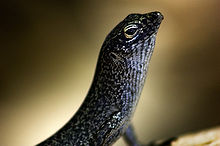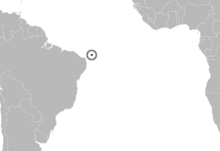Noronha skink
| Noronha skink | |
|---|---|
 |
|
| Scientific classification | |
| Kingdom: | Animalia |
| Phylum: | Chordata |
| Class: | Reptilia |
| Order: | Squamata |
| Family: | Scincidae |
| Genus: | Trachylepis |
| Species: | T. atlantica |
| Binomial name | |
|
Trachylepis atlantica (Schmidt, 1945) |
|
 |
|
| Location of Fernando de Noronha, the island to which the Noronha skink is endemic. | |
| Synonyms | |
|
|
The Noronha skink (Trachylepis atlantica) is a species of skink from the island of Fernando de Noronha off northeastern Brazil. It is covered with dark and light spots on the upperparts and is usually about 7 to 10 cm (3 to 4 in) in length. The tail is long and muscular, but breaks off easily. Very common throughout Fernando de Noronha, it is an opportunistic feeder, eating both insects and plant material, including nectar from the Erythrina velutina tree, as well as other material ranging from cookie crumbs to eggs of its own species. Introduced predators such as feral cats prey on it and several parasitic worms infect it.
Perhaps seen by Amerigo Vespucci in 1503, it was first formally described in 1839. Its subsequent taxonomic history has been complex, riddled with confusion with Trachylepis maculata and other species, homonyms, and other problems. The species is classified in the otherwise mostly African genus Trachylepis and is thought to have reached its island from Africa by rafting. The enigmatic Trachylepis tschudii, supposedly from Peru, may well be the same species.
In an early account of what may be Fernando de Noronha, purportedly based on a voyage by Amerigo Vespucci in 1503, the island was said to be inhabited by "lizards with two tails", which is thought be a reference to the Noronha skink. The tail is long and fragile, and it breaks easily, like that of many skinks and other lizards, following which it may regenerate. However, when it does not completely break off, a new tail may nevertheless grow out of the broken part, so that the tail appears forked.
...
Wikipedia
